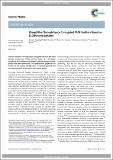(Deep) blue through-space conjugated TADF emitters based on [2.2]paracyclophanes
Abstract
The first examples of through-space conjugated thermally activated delayed fluorescence (TADF) emitters based on a [2.2]para- cyclophane (PCP) skeleton with stacked (coplanar) donor-acceptor groups have been synthesized. The optoelectronic properties are studied by the relative configuration, cis (pseudo-geminal) and trans (pseudo-para), of the donor and acceptor groups.
Citation
Spuling , E , Sharma , N , Samuel , I , Zysman-Colman , E & Bräse , S 2018 , ' (Deep) blue through-space conjugated TADF emitters based on [2.2]paracyclophanes ' , Chemical Communications , vol. In press . https://doi.org/10.1039/C8CC04594A
Publication
Chemical Communications
Status
Peer reviewed
ISSN
1359-7345Type
Journal article
Description
E. S. and S. B. acknowledge funding from DFG in the frame of SFB1176 (projects A4, B3 and C6) and KSOP (fellowship to E. S.). E. Z.-C. and I. D. W. S. thank the Engineering and Physical Sciences Research Council (EPSRC) (No. EP/P010482/1) for financial support. I.D.W.S. also acknowledges support from a Royal Society Wolfson Research Merit Award.Collections
Items in the St Andrews Research Repository are protected by copyright, with all rights reserved, unless otherwise indicated.

